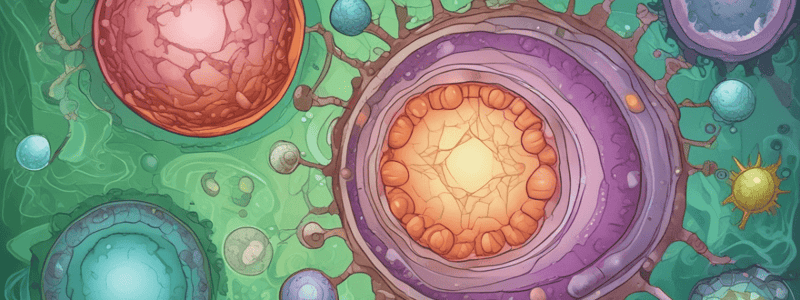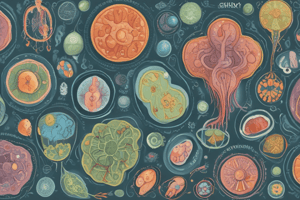Podcast
Questions and Answers
What is the study of microorganisms called?
What is the study of microorganisms called?
- Zoology
- Microbiology (correct)
- Ecology
- Botany
What is the jelly-like substance inside a cell called?
What is the jelly-like substance inside a cell called?
- Cytoplasm (correct)
- Plasma membrane
- Nucleus
- Mitochondria
What is the process of cell growth and reproduction called?
What is the process of cell growth and reproduction called?
- Photosynthesis
- Mitosis
- Metabolism
- Cell division (correct)
What is the mechanism of evolution that results in adaptation to the environment?
What is the mechanism of evolution that results in adaptation to the environment?
What is the pattern of fossilization that provides evidence for evolution?
What is the pattern of fossilization that provides evidence for evolution?
What are organisms that produce energy through photosynthesis or chemosynthesis called?
What are organisms that produce energy through photosynthesis or chemosynthesis called?
Flashcards are hidden until you start studying
Study Notes
Branches of Biology
- Botany: study of plants
- Zoology: study of animals
- Microbiology: study of microorganisms
- Ecology: study of interactions between organisms and their environment
- Biochemistry: study of chemical processes in living organisms
- Molecular Biology: study of biological molecules and their interactions
- Genetics: study of heredity and variation
Cellular Biology
- Cell Structure:
- Plasma membrane: outer layer of cell
- Cytoplasm: jelly-like substance inside cell
- Nucleus: contains genetic material (DNA)
- Mitochondria: generate energy for cell
- Cell Functions:
- Metabolism: energy conversion and synthesis
- Photosynthesis: conversion of light energy to chemical energy
- Cell division: process of cell growth and reproduction
Evolution
- Mechanisms of Evolution:
- Natural Selection: adaptation to environment
- Genetic Drift: random change in gene frequency
- Mutation: change in DNA sequence
- Gene Flow: movement of genes between populations
- Evidence for Evolution:
- Fossil Record: pattern of fossilization
- Comparative Anatomy: similarities and homologies between species
- Molecular Biology: similarities in DNA and protein sequences
Ecosystems
- Components of Ecosystems:
- Biotic factors: living organisms
- Abiotic factors: non-living components (e.g. light, temperature, water)
- Energy Flow:
- Producers: organisms that produce energy (e.g. plants)
- Consumers: organisms that obtain energy from producers
- Decomposers: organisms that break down organic matter
- Nutrient Cycles:
- Carbon Cycle: circulation of carbon through ecosystem
- Nitrogen Cycle: circulation of nitrogen through ecosystem
Biological Molecules
- Carbohydrates: energy storage and structural molecules
- Proteins: enzymes, structural components, and transport molecules
- Lipids: energy storage and structural molecules
- Nucleic Acids: DNA and RNA, storing genetic information
Studying That Suits You
Use AI to generate personalized quizzes and flashcards to suit your learning preferences.




